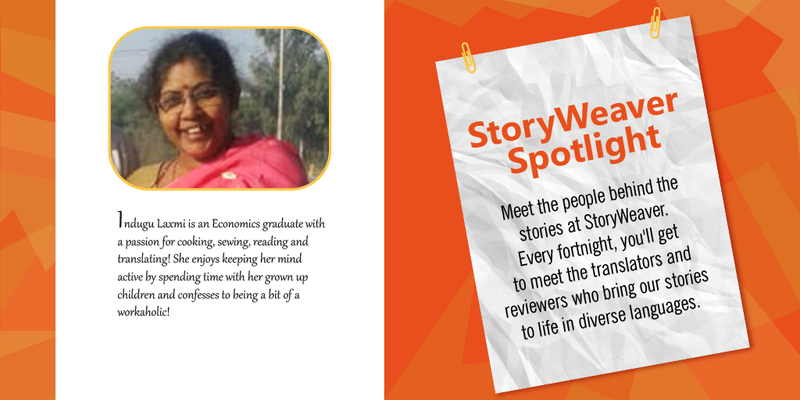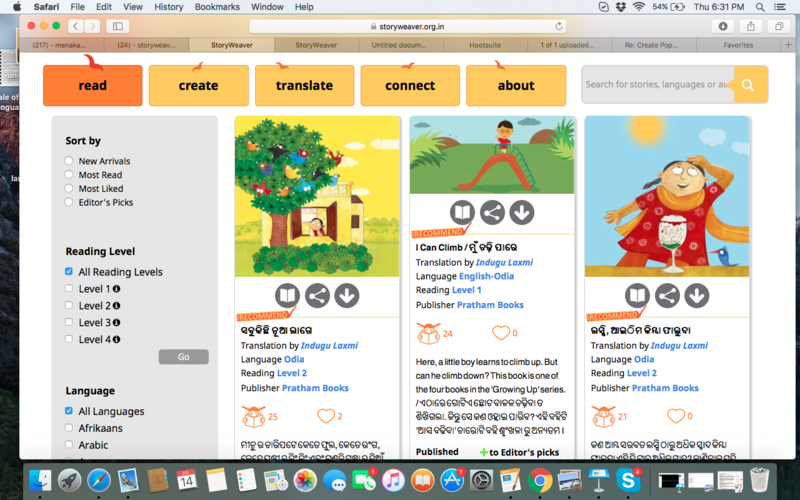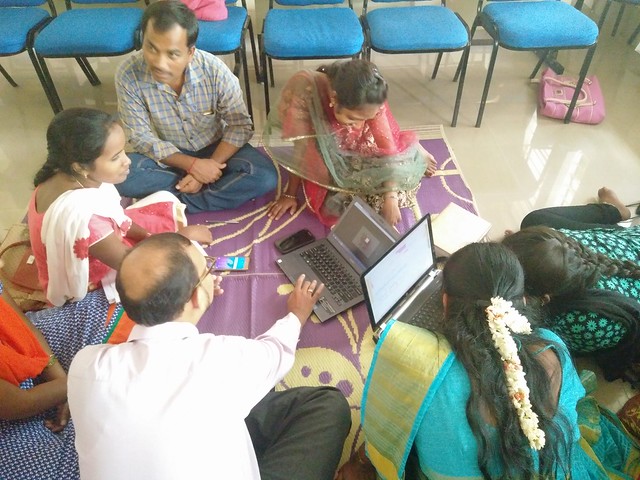A tale of two workshops. StoryWeaver visits Mumbai and Mysore.
Posted by Remya Padmadas on June 16, 2017Khyati Datt, a member of our outreach team writes about two of our recent workshops in Mumbai and Mysore.
It’s not often that you have 25 Master Teachers from different walks of life, speaking 5 different languages, living in 4 different states and still engaging with each other and sharing their thoughts.
This was the scene at our recently conducted StoryWeaver Workshop in Mysore. Pratham Education Foundation invited their wonderful Master Teachers for a training workshop in Mysore and we, at StoryWeaver, got the chance to interact with them on the last day of their training. Our facilitators, Mala, Shruthi and Payoshni ensured that the session was multilingual- in Kannada, Tamil, Telugu, English and Hindi.
The beautiful weather at Mysore served as the perfect setting for a 3-hour long session where interesting teacher practices came to light. As the session progressed, we deep dived into the intriguing world of stories and explored how stories open a child’s eyes to a world filled with joy and learning.
The teachers, then, went on to try their hands at StoryWeaver. They decided on themes and explored the platform for five stories/flashcards that talked about their theme. Their biggest takeaway from this exercise was that they can use the platform in their classrooms and combine storytelling with teaching. The second part of their task was getting down to becoming authors! Each group was given a task sheet with a specific theme and encouraged to create a story/flashcard. The most exciting bit was teachers realizing how easy it is for them to create in their regional languages and taking it to their classrooms back home.
We got some great stories from the teachers, who presented their idea for the story and the flow behind it. With so many tongues in the room, everyone promptly translated what was being spoken in the room which ensured language was not a barrier for a fantastic session of idea-exchanges.
A discussion ensued on what are the different ways in which the teachers can use StoryWeaver in the classrooms. It was wonderful to see how the teachers could align their existing classroom ideas with storytelling practices, like by getting their students excited about a topic by narrating them a story about it. Using illustrations as writing prompts, and spotting books for teaching sight words were one of the many ideas that the teachers dwelled on.
We closed the session by showing the participants videos of teachers using StoryWeaver to build a reading culture in their classrooms. The rain shower that followed was the perfect end to a wonderful workshop!
In the previous week, a similar workshop was conducted in Bombay with 30 teachers from Pratham’s ECE wing from Maharashtra and Gujarat. The crackling energy in the room led to a session that was interactive and fun! The teachers came up with ideas to use stories in the classroom to make the lessons engaging and to ensure that the students learn in a different manner. As Smitin Brid, Program Head of Early Childhood Program for Pratham Education Foundation, puts it, “ I’m thankful to the StoryWeaver team for conducting wonderful and useful sessions at Mumbai and Mysore workshops. The key resource people in both these regions have got information about this platform and we’ll ensure continuous engagement with them on using the resources available on StoryWeaver.”
A big thank you to Pratham Education Foundation and its ECE wing for giving us the opportunity to interact with the teachers and their consistent support.
If you are interested in hosting a similar workshop for your organisation, drop us an email on [email protected]
Be the first to comment.StoryWeaver Spotlight: Indugu Laxmi
Posted by Remya Padmadas on September 16, 2016 
Q: What do you usually read? Which language do you prefer to read in?
A: I read whatever I get to and whatever I find interesting: from newspapers, magazines, online articles, my children's academic books to everything! I prefer to read in English the most.
Q: Do you have a favorite book / author and why is it a favorite?
A: I find no particular book or author as my favorite, I love many books, many authors and many languages.
Q: You have contributed for us immensely. How has the StoryWeaver journey been?
A: Simply GREAT! I have learnt many new things, I discovered the ability to express my thoughts in a simple manner.
Q: Could you share with us a story or anecdote from the translations / reviews? Or one big thing that you take away from this experience?
A: Not just one or two things, I have learnt so much and experienced so many things from these children books. In one of Pratham Books’ Annual Storytelling sessions in Delhi, I went to a Telugu school to conduct a Telugu story-telling session, I was apprehensive about the response of the staff and most importantly the kids with whom I was supposed to interact. But to my surprise, at the end of the session I was very emotional with tears in my eyes, I was encircled by so many small children, requesting for more stories. I was totally a stranger to them but the stories made me their favorite, the feeling was indescribable. It was a moment I will treasure all my life.
Q: How does it feel when your story gets published online?
A: Great! Because being a person of seventies and eighties, that too coming from Odisha a state, wrongly labeled as backward and poor it feels GREAT when I think I am not lagging behind with the modern time and methods, and whatever I am doing I am repaying my debt to my mother state.

Q: You have translated / reviewed a handful of stories for us. Which one has been your favourite and why?
A: My favorite book is 'We Call Her Ba', the book is about Smt.Kasturba Gandhi. Though I had read about the freedom struggle and Gandhiji in my student days, this book took me to a period of time not familiar to me. I loved the language, narration and everything about it.
Q: What is your key driver in taking this up?
A: The driving cause is the concept of introducing children to stories of languages other than their mother tongue. The exposure to different kinds literature in one’s childhood transforms the child into a person of responsible nature, knowledgeable, and more tolerant towards other cultures which is the need of the hour at present.
Q: How else do you think we can join hands in taking bigger steps for children’s literature?
A: I feel I have no such high intelligence to offer any constructive ideas but in my small mind I feel that, in these TV addiction days it will get more attractive for children if the story telling or narrating session could be telecast on television.
Q: How has the overall experience with StoryWeaver been?
Ans. ବହୁତ ବଢ଼ିଆ , ତୃପ୍ତିକର କାମ | Very Pleasant, Highly satisfying .
Q: How did you cross the technology barrier for this?
A: Without facing much difficulty. I always want to change with times and like to keep pace with my grown up children so my children taught me everything . They encouraged me a lot and boosted my confidence. So it was smooth sailing.
To read all the wonderful translations by Indugu on SW, click here!
comments (3)StoryWeaver Spotlight: Nivedha
Posted by Remya Padmadas on July 01, 2019Nivedha is a Physics graduate currently working in the field of education. She enjoys taking science to kids through stories. She has translated many stories to Tamil for Pratham Books including 'Talking in Twos' and 'This is How You Count Eggs'. You can read her stories The Girl Who Thinks in Numbers: Data Warrior Prukalpa Sankar and The Scavenger Hunt on StoryWeaver. 
Q: Can you tell us anything about yourself and your job that would surprise us :) ?
I am a mildly mischievous person with good observation skills. No wonder I chose to study science and became a physics graduate eventually. Now I work in an education-based organisation where I develop content for school kids. While designing language lessons, I try to include storytelling elements to it. It’s quite interesting!
Q: What is your personal relationship to language and/or translation?
Being a single child to my parents, books have been the biggest companion to me since childhood. I remember reading books even when I couldn’t understand the meaning of most parts of the text. Language feels like a cosy and comfortable space that my mind loves going to!
Q: When you’ve been given a story to translate, what’s your process, and how long does it generally take?
First, I read the story three to four times. During the initial reads, I consciously ignore the fact that I am reading it for the purpose of translation. It helps to grasp how a particular story might feel/appeal to a reader.
In the next step, I read about the region/culture where the story happens. For STEM stories I make sure that I revise/read the science concepts that are dealt with. This process I stretch across a few days to a week and when I sit to write it down it doesn’t take more than a few hours.
Q: In your opinion, what do stories in translation bring to young readers?
Children love exploring new things. These stories provide an exposure to other cultures and people. I believe it helps the kids to know about the differences existing among us or feel that it is okay to be different.
Q: How did you cultivate the skills needed to translate books for children?
Translation is relatively a new thing to me and I have a lot to learn. I read children stories and translated stories. Reading translation related discussions on digital platforms also help me. I also watch child centred cartoons like ‘Peppa Pig’ where an episode is like a visual short story of 5 minutes and then imagine how we can give similar experience through the text .
Q: What was the experience of translating a children’s book like, compared to translating for adults?
The exposure and worldview that a child has is very different from what an adult would have. So this has to be kept in mind too. Also, while translating for adults I feel there is a liberty to use slang, but for children had to go back to the basic words. During this process, I also learnt(had to learn) new words whose usage is not very common in spoken language.
Q: You are also a Physics graduate who loves the subject. How is the experience of translating STEM based stories? Are there any particular experiences/opinions from this experience?
I believe children grasp things quickly when it’s told as a story spun around their world and experiences. In that way, translating STEM based stories make me happy as it helps in taking science to kids in an interesting way.
Especially, while translating the story “The Scavenger Hunt”, I was delighted at how the basic concept of filtration was taken and woven into the story. When Lajjo (the main character) goes in search of tools, we could see that how a tool/object is accessed/placed varies for each culture. It gave me an insight that our interaction with the material world is not the same and thus teaching science in the same way to everyone may not work in all cases.

Q: What is the hardest thing about translating from English to Tamil? How do you navigate words or phrases that are tricky to translate?
I find translating the technical words/jargons to Tamil the hardest. Most times people would be familiar with the actual English terms than Tamil. In that case I refer to dictionaries, other tests and try to use an easier, relatable Tamil equivalent. I also cross check with my friends if they can understand that word/phrase.
Q: How else do you think we can join hands to take more stories to more children in more languages?
Book fairs are a great way to reach Children. The publications concentrating on children and young adult literature can collaborate and come up with a dedicated stall for them. (This from my experience in Chennai book fair. Though many kids come, availability of books in regional languages is not sufficient.)
This platform can also be used to attract talent who are interested in children’s literature.
Q: What type of person do you think makes the best translator for children stories?
Anyone who has a love for language and is open to learn from everyone and everything can make a good translator.
Q: Do you have any advice for anyone interested in becoming a translator?
I think I still am in a place to receive a lot of it? 😊 Anyways, I would say to be open to learning and observe the language of people around you. It helps a lot.
Q. A book you would recommend to other translators?
Eriyum panikkaadu (எரியும் பனிக்காடு) by R. Murugavel (Originally written in English by P.H.Daniel). I didn’t even have the slightest thought that ‘Eriyum panikkaadu’ could be a translated book when I first read it. Such was the flow of text in the translation. Isn’t that an aim of every translator!
Be the first to comment.